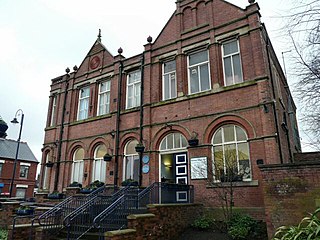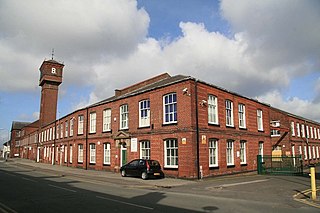
Henri Farman was a British-French aviator and aircraft designer and manufacturer with his brother Maurice Farman. Before dedicating himself to aviation he gained fame as a sportsman, specifically in cycling and motor racing. Henri acquired French nationality in 1937.

Denton is a town in Tameside, Greater Manchester, England, five miles (8 km) east of Manchester city centre. Historically part of Lancashire, it had a population of 36,591 at the 2011 Census.

Stockport is an industrial town in Greater Manchester, England, 7 miles (11 km) south-east of Manchester, 9 miles (14 km) south-west of Ashton-under-Lyne and 12 miles (19 km) north of Macclesfield. The River Goyt and Tame merge to create the River Mersey here. It is the main settlement of the wider Metropolitan Borough of Stockport.

Reddish is an area in Metropolitan Borough of Stockport, Greater Manchester, England. 4.6 miles (7.4 km) south-east of Manchester city centre. At the 2011 census, the population was 28,052. Historically part of Lancashire, Reddish grew rapidly in the Industrial Revolution and still retains landmarks from that period, such as Houldsworth Mill, a former textile mill.

The Fairey Aviation Company Limited was a British aircraft manufacturer of the first half of the 20th century based in Hayes in Middlesex and Heaton Chapel and RAF Ringway in Cheshire that designed important military aircraft, including the Fairey III family, the Swordfish, Firefly, and Gannet. It had a strong presence in the supply of naval aircraft, and also built bombers for the RAF.

Marple is a town in the Metropolitan Borough of Stockport, Greater Manchester, England. It is on the River Goyt, 9 miles (14 km) south-east of Manchester, 9 miles (14 km) north of Macclesfield and 4 miles (6 km) south-east of Stockport. In 2011, it had a population of 23,686.

The Stockport Branch Canal was a 5-mile (8 km) branch of the Ashton Canal from Clayton to Stockport.

The Metropolitan Borough of Stockport is a metropolitan borough of Greater Manchester in England. It is south-east of central Manchester and south of Tameside. As well as the towns of Stockport, Bredbury and Marple, it includes the outlying villages and suburbs of Hazel Grove, Bramhall, Cheadle, Cheadle Hulme, Gatley, Reddish, Woodley and Romiley. In 2021, it had a population of 295,243, making it the fourth-most populous borough of Greater Manchester.

Guide Bridge railway station serves Guide Bridge in Audenshaw, Greater Manchester, England, and is operated by Northern Trains. The station is 4+3⁄4 miles (7.6 km) east of Manchester Piccadilly on both the Rose Hill Marple and Glossop Lines.

Reddish Vale is in the Tame Valley close to Reddish, Greater Manchester, England. The centre of the vale is around the bottom of Reddish Vale Road. Reddish Vale Country Park is a country park managed by Stockport Metropolitan Borough Council (SMBC). It covers 161 hectares in all and comprises some of the traditional Reddish Vale area, Reddish Vale Farm and the grazing land and Woodhall Fields, about 0.5 miles (0.80 km) to the south. Part of it is a designated local nature reserve.

Chater-Lea was a British bicycle, car and motorcycle maker with a purpose-built five-storey factory in Banner Street, EC1, in the City of London and, from 1928, premises at Letchworth, Hertfordshire. It was founded by William Chater-Lea in 1890 to make bicycle frames and components. It made cars between 1907 and 1922 and motorcycles from 1903 to 1935. William died in 1927 and the business was taken over by his sons John and Bernard. After vehicle production finished, the company remained trading as a bicycle component maker and contract manufacturer until 1987. The company relaunched in 2017 as a maker of high-end British manufactured bicycle components and launched its first new products in the summer of 2019.

The Hat Works is a museum in Stockport, Greater Manchester, England, which opened in 2000. Before that, smaller displays of hatting equipment were exhibited in Stockport Museum and in the former Battersby hat factory.
There is evidence of activity around Reddish – a settlement in Greater Manchester, England – before the Norman conquest in the presence of Nico Ditch and some Saxon coins. The recorded history of Reddish begins at the turn of the 13th century when it was documented as "Redich". Reddish remained a predominantly rural settlement throughout the medieval period, but expanded to become a mixed industrial and residential area during the 19th century. It developed rapidly during the Industrial Revolution, and still retains landmarks from that period, such as Houldsworth Mill.

Conty is a commune in the Somme department in Hauts-de-France in northern France.

50 Newton Street is a Grade II listed former warehouse in Manchester, England. It is located on Newton Street in the Northern Quarter area
Associated British Hat Manufacturers Ltd was a holding company formed in 1966, by merging five of Britain's largest felt hat manufacturers. The intention was to rationalize a struggling industry that faced a declining market and foreign competition.

William Miller Christy (1778–1858) was an English Quaker hat and textile manufacturer, known also as a banker. He is credited with the invention of the penny receipt-stamp.

James Larratt Battersby was a British fascist and pacifist, and a member of the Battersby family of hatmakers of Stockport, Greater Manchester, England. He was forced to retire from the family firm due to his politics and was interned by the British government during the Second World War along with other British fascists. During his detention he came to believe that Adolf Hitler was Christ returned, and after the war wrote The Holy Book and Testament of Adolf Hitler. He committed suicide by leaping into the paddle wheels of a ferry.

James Johnson Battersby (1875–1949) was a British hat manufacturer. He was one of seven brothers, a number of whom worked in the family firm of Battersby Hats which at one time was one of the largest hat manufacturers in Britain. In 1915, he was the last survivor to be rescued after the RMS Lusitania was hit by a German torpedo and sunk. His son was the British fascist James Larratt Battersby.

William John Battersby JP was a British hat manufacturer, of Battersby Hats.




















